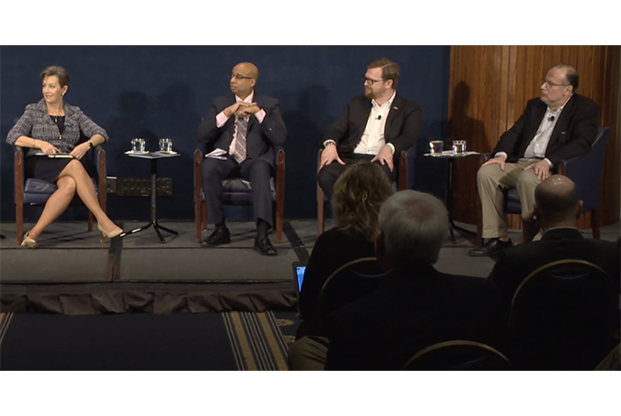
(From left to right) Rebecca Cowen-Hirsch, senior vice president for government strategy and policy with Inmarsat; Allen Herbert, vice president of business development and strategy for NanoRacks; Andrew Rush, president & CEO of Made In Space, Inc.; and Courtney Stadd, director of government affairs for Vector-Launch, speak at the Space Foundation's "State of Space" event in Washington on Jan. 30, 2019. Screenshot photo.
Commercial space industry members and a top Air Force Space Command official this month downplayed the idea that a recent spate of layoffs—including about 600 SpaceX employees—may indicate deeper sustainability problems in the nearly $400 billion global space sector.
At the Space Foundation’s “State of Space” event in downtown Washington on Jan. 30, speakers offered a rosy look at the future of an industry Commerce Secretary Wilbur Ross projects will eventually gross $1 trillion each year. The market is still vibrant and companies continue to hire, argued Allen Herbert, vice president of business development and strategy at NanoRacks, which offers commercial space station hardware and launch services.
Herbert said SpaceX’s Jan. 11 announcement it would lay off about 10 percent of its workforce, “may not have gone as they expected. But in any type of industry, you’re going to have downturns.” Space X is one of only two entities certified for National Security Space launches.
Rebecca Cowen-Hirsch, senior vice president for government strategy and policy at Inmarsat, a leading global mobile satellite communications provider, noted layoffs are a reflection of how companies are using their workforce based on the ebbs and flows of programs and technology development. The next challenge, she said, is continuing to cultivate new workers who can address companies’ future needs.
“It’s almost a paradox … When you have a healthy system, you have people who will take advantage of people who were laid off from some of these other companies, technologies that may be repurposed and repackaged,” added Courtney Stadd, government affairs director at Vector-Launch, which offers low-cost microsatellite launches and software-centric satellites.
Job cuts reported within the past year at companies like Space Systems Loral, Moon Express, and Tethers Unlimited come as the Air Force boasts of continued investments in space assets and looks to broaden its ties with the commercial sector.
Still, the global space industry grew more than 7 percent in 2017, and government space budgets rose by nearly 14 percent, according to the Space Foundation’s annual report for 2018. Government spending on space accounted for nearly 20 percent of the world’s space economy.
AFSPC Vice Commander Lt. Gen. David Thompson told reporters last week that the Air Force accounts for when it might see significant changes in the industrial base—particularly for launch services—that could affect companies’ long-term viability and the military’s perspective.
“In terms of the commercial space industry and its viability, [there’s] always a little bit of a concern. In fact, 20 years ago when we started the Evolved Expendable Launch Vehicle program … we were hoping there would be a strong commercial demand signal for launch at that time. It didn’t pan out,” he said. “I think the situation’s a little different today. I think we’re more likely to be on the verge of a large commercial breakout.”
During the State of Space discussion, panelists suggested the Pentagon’s effort to create a Space Development Agency could help bolster the commercial sector if the SDA forges new connections with nontraditional contractors and removes burdensome requirements from its contract agreements.
“If, however, it’s another agency that’s going to focus on building Battlestar Galacticas for the Department of Defense and competing against what industry is doing on an innovative and affordable and technological scale, then it could go in the opposite direction,” Cowen-Hirsch said.
